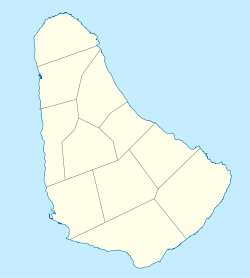Saint Ann's Fort
| Saint Ann's Fort | |
|---|---|
| Saint Michael, Barbados | |
 Former barracks at Saint Ann's Fort | |
| Coordinates | 13°04′43″N 59°36′25″W / 13.0787°N 59.6070°W |
| Type | Fortification |
| Site history | |
| Built | 1705 |
Saint Ann's Fort is a historic military fort in Barbados. It is located in the Garrison Historic Area (also known as St. Ann's Garrison or, more commonly, The Garrison).[1] It was built by the British in 1705, and named for Queen Anne of Great Britain.[1] Today, Saint Ann's Fort houses the Headquarters of the Barbados Defence Force and the Barbados Regiment,[1][2] as well as the Barbados National Armoury Museum.[3]
History
[edit]Construction of the fort began around 1705, after the start of the War of Spanish Succession.[4] It was originally called Saint Ann’s Castle,[5] and was named for the queen of Great Britain at that time, Queen Anne.[1] Unlike other forts on the island located on the coast, Saint Ann's Fort was built inland for back-up protection.[6] The fort was built hexagonal in shape.[7] It enclosed an acre and a half, with walls more than fifty yards long.[7] The fort was built in the Georgian style,[4] and its construction included vaulted underground magazines.[8] Its barracks could house 4,000 soldiers.[9]
In 1780, Saint Ann's Fort became the headquarters for British troops stationed in Barbados. Troops were stationed there from 1780 until 1905. In 1933, the fort's former British Military Prison became the headquarters of the Barbados Museum & Historical Society.[10][11][3] In 1979, the Barbados Defence Force was established.[12] Saint Ann's Fort is their headquarters.[13]
In 2004, the Barbados National Armoury Museum opened at St Ann’s Fort in a historic naval powder magazine located on the fort's grounds.[1] This museum has the world’s largest collection of 17th century English iron cannons, including a Commonwealth Cannon from 1652.[1]
In 2011, The Garrison, of which Saint Ann's Fort is a part, was made a UNESCO World Heritage Site.[14]
Gallery
[edit]-
Main guard house
-
Stone barracks
-
Canons
-
Barracks, drill house
-
Drawing of Saint Ann's Garrison, 1848
References
[edit]- ^ a b c d e f "National Armoury Museum". The Barbados Defence Force. Retrieved 2023-09-30.
- ^ Beruff, Jorge Rodriguez; Figueroa, J. Peter; Greene, J. Edward (1991-06-18). Conflict, Peace and Development in the Caribbean. Springer. ISBN 978-1-349-11877-9.
- ^ a b "Museum History - Barbados Museum & Historical Society". www.barbmuse.org.bb. Retrieved 2023-09-30.
- ^ a b Carrington, Sean; Fraser, Henry; Gilmore, John; Forde, G. Addinton (2003). A-Z of Barbados Heritage. Macmillan Caribbean. ISBN 978-0-333-92068-8.
- ^ Treasures of Barbados. Macmillan Caribbean. 1990. ISBN 978-0-333-53369-7.
- ^ Din, Undeleeb; Guides (Firm), Rough; Folster, Natalie (2005). The Rough Guide to the Caribbean. Rough Guides. ISBN 978-1-84353-514-0.
- ^ a b Society, Barbados Museum and Historical (1991). Journal of the Barbados Museum and Historical Society.
- ^ "Barbados: British Empire in Miniature | History Today". www.historytoday.com. Retrieved 2023-09-30.
- ^ Crain, Edward E. (2017-11-29). Historic Architecture in the Caribbean Islands. University Press of Florida. ISBN 978-1-947372-23-8.
- ^ "Two Officers and a Private of the West India Regiment watching an exercise at St Ann's Garrison, Barbados, 1886 | Online Collection | National Army Museum, London". collection.nam.ac.uk. Retrieved 2023-09-30.
- ^ "Barbados Museum & Historical Society | Lowcountry Digital Library". Retrieved 2023-09-30.
- ^ "About Us". The Barbados Defence Force. Retrieved 2023-09-30.
- ^ "History". The Barbados Defence Force. Retrieved 2023-09-30.
- ^ Centre, UNESCO World Heritage. "Barbados enters World Heritage List with Bridgetown and its Garrison; Hiraizumi (Japan) and Germany's Beech Forests also inscribed". UNESCO World Heritage Centre. Retrieved 2023-09-30.







